
You will enjoy this shape game. It tells you the name of a shape and all you have to do is click on the correct shape. If you get confused you can have another try.
- Subject:
- Mathematics
- Material Type:
- Game
- Date Added:
- 12/01/2023
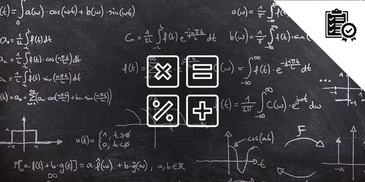

You will enjoy this shape game. It tells you the name of a shape and all you have to do is click on the correct shape. If you get confused you can have another try.

This site has a detailed step-by-step instruction of how to convert units of measurement. Multiplying by 1 is explained as are compound units, and finding conversion factors. The discussion is slowed down for students who may have missed the material the first time around.

Step-by-step explanations of the exponent laws including rules for combining powers and roots. Includes practice exercises.
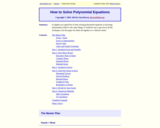
The many facets of factoring polynomials and solving polynomial equations are explained here in great detail. Taking students from basic definitions through the Descartes Rule of Signs, this is a valuable tool for math classes.

Students create projects that introduce them to Arduino—a small device that can be easily programmed to control and monitor a variety of external devices like LEDs and sensors. First they learn a few simple programming structures and commands to blink LEDs. Then they are given three challenges—to modify an LED blinking rate until it cannot be seen, to replicate a heartbeat pattern and to send Morse code messages. This activity prepares students to create more involved multiple-LED patterns in the Part 2 companion activity.

In the companion activity, students experimented with Arduino programming to blink a single LED. During this activity, students build on that experience as they learn about breadboards and how to hook up multiple LEDs and control them individually so that they can complete a variety of challenges to create fun patterns! To conclude, students apply the knowledge they have gained to create LED-based light sculptures.
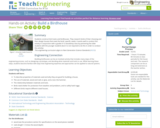
Students construct bird nests and birdhouses. They research birds of their choosing and then design houses that meet the birds' specific needs. It works well to conduct this activity in conjunction with a grades 9-12 woodshop class by partnering the older students with the younger students (but it is not required to do this in order to conduct the activity).

Working as if they are engineers who work for (the hypothetical) Build-a-Toy Workshop company, students apply their imaginations and the engineering design process to design and build prototype toys with moving parts. They set up electric circuits using batteries, wire and motors. They create plans for project material expenses to meet a budget.
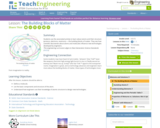
Students learn about atoms and their structure (protons, electrons, neutrons) — the building blocks of matter. They see how scientific discoveries about atoms and molecules influence new technologies developed by engineers.

Steve Hinds demonstrates how a brief discussion of money and decimals can help students to shed common misconceptions about decimal place value.
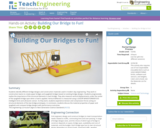
Students identify different bridge designs and construction materials used in modern day engineering. They work in construction teams to create paper bridges and spaghetti bridges based on existing bridge designs. Students progressively realize the importance of the structural elements in each bridge. They also measure vertical displacements under the center of the spaghetti bridge span when a load is applied. Vertical deflection is measured using a LEGO MINDSTORMS(TM) NXT intelligent brick and ultrasonic sensor. As they work, students experience tension and compression forces acting on structural elements of the two bridge prototypes. In conclusion, students discuss the material properties of paper and spaghetti and compare bridge designs with performance outcomes.
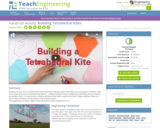
Working in teams of four, students build tetrahedral kites following specific instructions and using specific materials. They use the basic processes of manufacturing systems – cutting, shaping, forming, conditioning, assembling, joining, finishing, and quality control – to manufacture complete tetrahedral kites within a given time frame. Project evaluation takes into account team efficiency and the quality of the finished product.
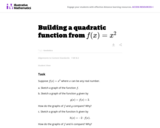
This is the first of a series of task aiming at understanding the quadratic formula in a geometric way in terms of the graph of a quadratic function.
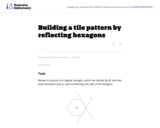
This task applies reflections to a regular hexagon to construct a pattern of six hexagons enclosing a seventh: the focus of the task is on using the properties of reflections to deduce this seven hexagon pattern.
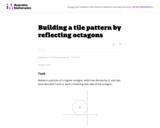
This task applies reflections to a regular octagon to construct a pattern of four octagons enclosing a quadrilateral: the focus of the task is on using the properties of reflections to deduce that the quadrilateral is actually a square.
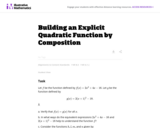
This task is intended for instruction and to motivate "Building a general quadratic function.''

Earthquakes happen when forces in the Earth cause violent shaking of the ground. Earthquakes can be very destructive to buildings and other man-made structures. Design and build various types of buildings, then test your buildings for earthquake resistance using a shake table and a force sensor that measures how hard a force pushes or pulls your building.

Students are introduced to some basic civil engineering concepts in an exciting and interactive manner. Bridges and skyscrapers, the two most visible structures designed by civil engineers, are discussed in depth, including the design principles behind them. To help students visualize in three dimensions, one hands-on activity presents three-dimensional coordinate systems and gives students practice finding and describing points in space. After learning about skyscrapers, tower design principles and how materials absorb different types of forces, students compete to build their own newspaper towers to meet specific design criteria.The unit concludes with student groups using balsa wood and glue to design and build tower structures to withstand vertical and lateral forces.
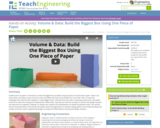
Student pairs are given 10 minutes to create the biggest box possible using one piece of construction paper. Teams use only scissors and tape to each construct a box and determine how much puffed rice it can hold. Then, to meet the challenge, they improve their designs to create bigger boxes. They plot the class data, comparing measured to calculated volumes for each box, seeing the mathematical relationship. They discuss how the concepts of volume and design iteration are important for engineers. Making 3-D shapes also supports the development of spatial visualization skills. This activity and its associated lesson and activity all employ volume and geometry to cultivate seeing patterns and understanding scale models, practices used in engineering design to analyze the effectiveness of proposed design solutions.

Students will learn how to draw a line of best fit for a set of data using m&m's and a "Bungee."